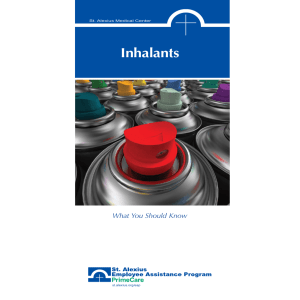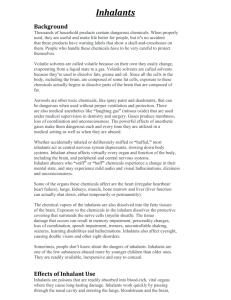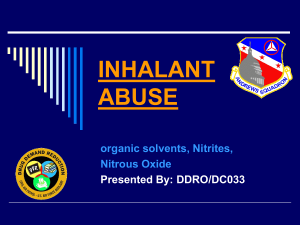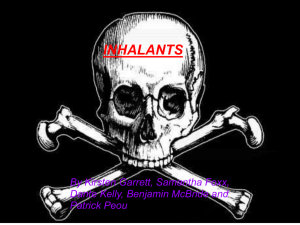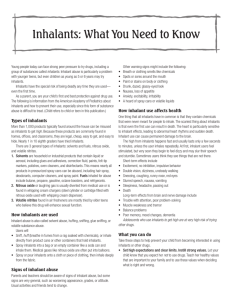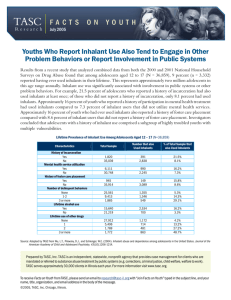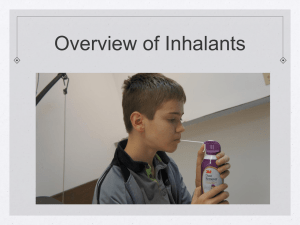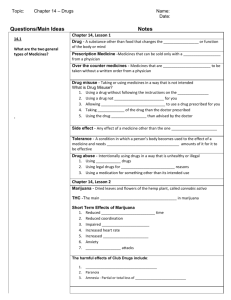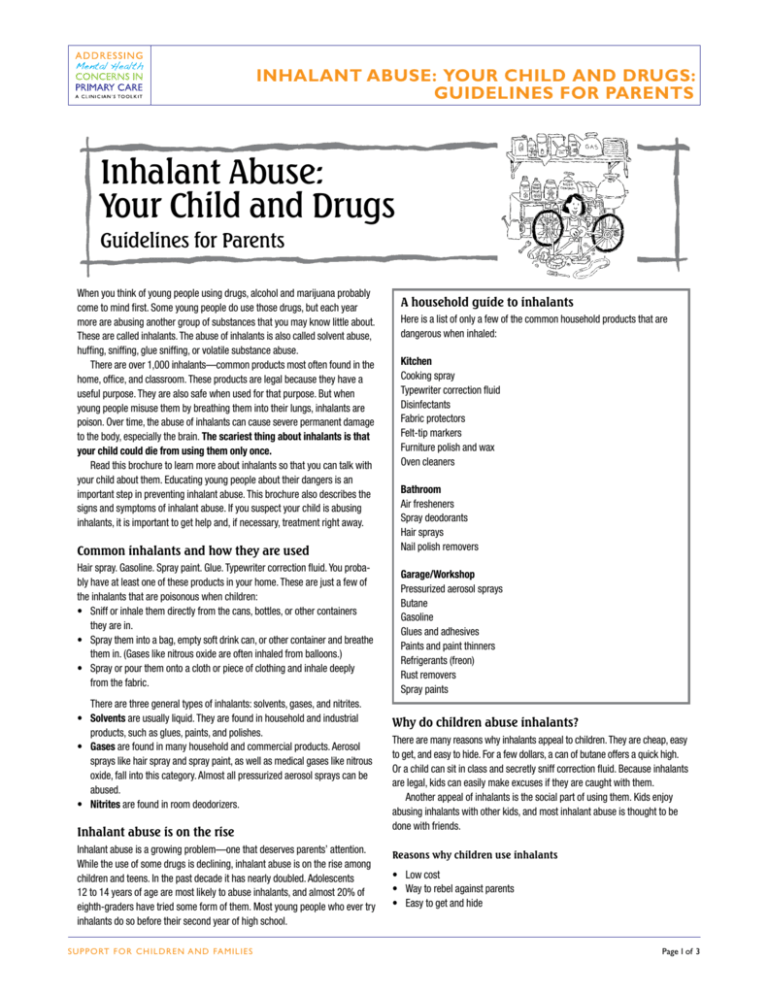
INHALANT ABUSE: YOUR CHILD AND DRUGS:
GUIDELINES FOR PARENTS
Inhalant Abuse:
Your Child and Drugs
Guidelines for Parents
When you think of young people using drugs, alcohol and marijuana probably
come to mind first. Some young people do use those drugs, but each year
more are abusing another group of substances that you may know little about.
These are called inhalants. The abuse of inhalants is also called solvent abuse,
huffing, sniffing, glue sniffing, or volatile substance abuse.
There are over 1,000 inhalants—common products most often found in the
home, office, and classroom. These products are legal because they have a
useful purpose. They are also safe when used for that purpose. But when
young people misuse them by breathing them into their lungs, inhalants are
poison. Over time, the abuse of inhalants can cause severe permanent damage
to the body, especially the brain. The scariest thing about inhalants is that
your child could die from using them only once.
Read this brochure to learn more about inhalants so that you can talk with
your child about them. Educating young people about their dangers is an
important step in preventing inhalant abuse. This brochure also describes the
signs and symptoms of inhalant abuse. If you suspect your child is abusing
inhalants, it is important to get help and, if necessary, treatment right away.
Common inhalants and how they are used
Hair spray. Gasoline. Spray paint. Glue. Typewriter correction fluid. You probably have at least one of these products in your home. These are just a few of
the inhalants that are poisonous when children:
• Sniff or inhale them directly from the cans, bottles, or other containers
they are in.
• Spray them into a bag, empty soft drink can, or other container and breathe
them in. (Gases like nitrous oxide are often inhaled from balloons.)
• Spray or pour them onto a cloth or piece of clothing and inhale deeply
from the fabric.
There are three general types of inhalants: solvents, gases, and nitrites.
• Solvents are usually liquid. They are found in household and industrial
products, such as glues, paints, and polishes.
• Gases are found in many household and commercial products. Aerosol
sprays like hair spray and spray paint, as well as medical gases like nitrous
oxide, fall into this category. Almost all pressurized aerosol sprays can be
abused.
• Nitrites are found in room deodorizers.
Inhalant abuse is on the rise
Inhalant abuse is a growing problem—one that deserves parents’ attention.
While the use of some drugs is declining, inhalant abuse is on the rise among
children and teens. In the past decade it has nearly doubled. Adolescents
12 to 14 years of age are most likely to abuse inhalants, and almost 20% of
eighth-graders have tried some form of them. Most young people who ever try
inhalants do so before their second year of high school.
S U P P O RT F O R C H I L DREN AND FAMILIES
A household guide to inhalants
Here is a list of only a few of the common household products that are
dangerous when inhaled:
Kitchen
Cooking spray
Typewriter correction fluid
Disinfectants
Fabric protectors
Felt-tip markers
Furniture polish and wax
Oven cleaners
Bathroom
Air fresheners
Spray deodorants
Hair sprays
Nail polish removers
Garage/Workshop
Pressurized aerosol sprays
Butane
Gasoline
Glues and adhesives
Paints and paint thinners
Refrigerants (freon)
Rust removers
Spray paints
Why do children abuse inhalants?
There are many reasons why inhalants appeal to children. They are cheap, easy
to get, and easy to hide. For a few dollars, a can of butane offers a quick high.
Or a child can sit in class and secretly sniff correction fluid. Because inhalants
are legal, kids can easily make excuses if they are caught with them.
Another appeal of inhalants is the social part of using them. Kids enjoy
abusing inhalants with other kids, and most inhalant abuse is thought to be
done with friends.
Reasons why children use inhalants
• Low cost
• Way to rebel against parents
• Easy to get and hide
Page 1 of 3
INHALANT ABUSE: YOUR CHILD AND DRUGS: GUIDELINES FOR PARENTS
• Peer pressure or influence
• Not illegal to possess, so kids can make excuses if they are caught
with inhalants
• Public is not aware of the dangers
Signs and symptoms of inhalant abuse
•
•
•
•
•
•
Breath and clothing that smells like chemicals
Spots or sores around the mouth
Paint or stains on body or clothing
Drunk, dazed, or glassy-eyed look
Nausea, loss of appetite
Anxiety, excitability, irritability
Prevention of inhalant abuse
Although some states have laws to try and deal with inhalant abuse, such laws
are not always easy to enforce. Since inhalants are legal and kids can get them
from so many different ways, it is not possible to make inhalants entirely offlimits. The best way to fight inhalant abuse is to educate your child about how
harmful these products are. Explain how they can cause both short- and longterm health problems, further drug abuse, and death. It is important to start
talking with children at a young age, because inhalant abuse often starts as
young as 8 or 9 years old. Parents and teachers should also be able to
recognize the warning signs of inhalant abuse.
Help prevent your child from turning to inhalants and other drugs by taking
these steps:
Set a good example at home. As a parent, you are the best role model
for your child. Parents who use drugs also place their children at higher risk
for drug use.
Build self-esteem and confidence. Praise your child often. Encourage
your son or daughter to set goals and make decisions to achieve them. With
each success and your constant support, your child will become more confident in what he or she can do. Children with self-confidence feel good about
themselves without needing drugs.
Help your child develop different interests. Encourage your child to
read, have hobbies, play sports, or join clubs. These activities can keep your
son or daughter from using drugs out of boredom or from having too much
free time. Young people will find that they can have a lot of fun and feel good
without drugs. Take an active interest in your child’s interests and in his or
her friends.
S U P P O RT F O R C H I L DREN AND FAMILIES
Help your child resist peer pressure. Being independent and self-confident can help your child resist pressure from friends to abuse inhalants. To
foster independence, show confidence in your child’s ability to make his or her
own decisions. Encourage your child to make his or her own judgments, no
matter what friends or others say or do.
Talk openly and often. Talk about things that are important to and relevant
in your child’s life. This includes discussing drugs and how some kids might
use them to be accepted by their peers. Educating your pre-teen or teen about
the dangers of drugs, including inhalant abuse, works best through talking
rather than lecturing.
Treatment of inhalant abuse
When children are abusing inhalants, many times their parents do not find out
until the abuse has already become a habit. Chronic inhalant abusers are hardest to treat because they often have many serious personal and social problems. They also have difficulty staying off inhalants and have very high rates of
relapse. All of these reasons can keep chronic inhalant abusers from benefiting
from many drug abuse treatment programs.
Toxic chemicals from inhalants stay in the body for weeks. Because of this,
when chronic abusers stop using inhalants they may feel the effects of withdrawal for weeks. Withdrawal is the body’s way of getting over its physical
addiction to inhalants. During withdrawal from inhalants, a person may have:
• Hand tremors
• Excess sweating
• Constant headaches
• Nervousness
Treatment for inhalant abusers is usually long-term, sometimes as long as
2 years. It must address the many social problems most inhalant abusers have
and involves:
• Support of the child’s family
• Moving the child away from unhealthy friendships with other abusers
• Teaching and fostering better coping skills
• Building self-esteem and self-confidence
• Helping the child adjust to school or another learning setting
Inhalant abuse is a difficult form of substance abuse to treat. It is best to
recognize and start treatment before the problem becomes a habit. Parents and
educators need to be able to recognize the signs of inhalant abuse, especially
because most abusers do not seek treatment on their own.
Parents also play the most important role in helping their children to resist
abusing inhalants in the first place. The most effective prevention of inhalant
abuse is through the education of parents, teachers, and school-aged children.
Page 2 of 3
child
How do inhalants kill?
No one can predict how much of an inhalant will kill. A young person can
use a certain amount one time and seem fine, but his or her next use could
on is that they contain chemicals
be fatal.YOUR CHILD AND DRUGS: GUIDELINES FOR PARENTS
me. So why would anyone
breathe ABUSE:
INHALANT
The Texas Commission on Drugs and Alcohol Abuse reports the followusers of other drugs, inhalant
ing
ways that inhalants can kill:
als.
•
Asphyxia—Solvent
gases can cause a person to stop breathing from a
y a few minutes, unless users
lack
of
oxygen.
How do inhalants kill?
stimulating effect. ThenInformation
if the
for you and your child
• Choking—Users can choke on their own vomit.
dizzy, and have trouble What
walking.
are the effects of inhalants?
No one can predict how much of an inhalant will kill. A young person can
• Suffocation—This is more common among users who inhale from
hey see things that are not there.
use a certain amount one time and seem fine, but his or her next use could
have in common is that they contain chemicals
plastic bags.
an cause people to passOne
out.thing that all inhalants
be fatal.
that were never•meant
for people to consume.
So why
would
anyone breathe
Injuries—Inhalants
can cause
people
to become
careless or aggressive.
halants.
The Texas
Commission on Drugs and Alcohol Abuse reports the followtoxic enter
chemicals on This
purpose?
the users of
other
inhalant
often Just
leadslike
to behaviors
that
candrugs,
injure or
kill, such as operating
a
amounts of toxic chemicals
ing
ways
that
inhalants
can kill:
abusers
try
to
get
“high”
from
the
chemicals.
motor vehicle dangerously or jumping from great heights. Teens also can
nto the brain. There they damage
•
Asphyxia—Solvent
gases
can cause a person to stop breathing from a
The
effects
of
inhalants
usually
last
only
a
few
minutes,
unless
users
get burned or even be killed if someone lights a cigarette while they are
young person inhales greatly
lack of oxygen.
inhale
repeatedly.
At
first,
inhalants
have
a
stimulating
effect.
Then
if
the
huffing
butane,
gasoline,
or
some
other
flammable
substance.
workplace setting. It takes at least
• Choking—Users can choke on their own vomit.
users keep inhaling,
they may feel dazed,
dizzy,
trouble
• Suicides—Coming
down
fromand
anhave
inhalant
highwalking.
causes some people
the chemicals in inhalants.
• Suffocation—This is more common among users who inhale from
or think
theymay
seelead
things
thattoare
there.
to aggressive
feel depressed,
which
them
takenottheir
own lives.
aling, which is why an Sometimes
inhalant users get
plastic
Stronger
or repeated
inhaling can cause
to pass
out. the heart beat
• Cardiac
arrest—Chemicals
from people
inhalants
can make
verybags.
s. Inhalants also pass out
of the chemicals
•
Injuries—Inhalants
can cause people to become careless or aggressive.
A user can also diefast
suddenly
from usingthen
inhalants.
and irregularly,
suddenly stop beating. This is called cardiac
This
often
leads
to
behaviors
that can injure or kill, such as operating a
When someonearrest.
uses anOne
inhalant,
large
amounts
of
toxic
chemicals
enter
reason why this might happen is that inhalants somehow
motor
vehicle
dangerously
or
jumping
from great heights. Teens also can
the lungs and passmake
from the bloodstream
into
the
brain.
There
they
damage
heart extra-sensitive to adrenaline. (Adrenaline is a hormone
urred and slow speech
burned or even be killed if someone lights a cigarette while they are
and kill brain cells.that
The the
amount
fumes a young
inhalesto greatly
bodyofproduces,
usuallyperson
in response
fear, excitement, orget
surood changes
huffing butane, gasoline, or some other flammable substance.
exceeds what is considered
safe even
in aofworkplace
It takes
least
prise.) A sudden
rush
adrenalinesetting.
combined
withatinhalants
can make
allucinations
•
Suicides—Coming
down from an inhalant high causes some people
2 weeks for the body
get rid
of instantly.
some of the
in inhalants.
thetoheart
stop
Thischemicals
“Sudden Sniffing
Death,” as it is called,
is
to
feel
depressed,
which
may lead them to take their own lives.
Inhalants exit the body
mainly through
is why an
responsible
for moreexhaling,
than halfwhich
of all deaths
dueinhalant
to inhalant abuse.
•
Cardiac
arrest—Chemicals
from inhalants can make the heart beat very
abuser’s breath often smells like chemicals. Inhalants also pass out of the
Muscle spasms
Another very real danger of inhalants is that they often lead youngfast
people
and irregularly, then suddenly stop beating. This is called cardiac
body through urine.
ermanent brain damage
to try other drugs whose effects are even more intense and last longer.
arrest. One reason why this might happen is that inhalants somehow
Short-term effects of inhalants are:
eath
make the heart extra-sensitive to adrenaline. (Adrenaline is a hormone
• Headaches, nausea, vomiting • Slurred and slow speech
that the body produces, usually in response to fear, excitement, or sur• Loss of balance
• Mood changes
prise.)
A sudden rush of adrenaline combined with inhalants can make
• Dizziness
Hallucinations
The information contained•in this
publication should not be used as a substitute for the
the
heart
Over time, inhalants
can
cause
moreof your pediatrician. There may be variations in treatment that your stop instantly. This “Sudden Sniffing Death,” as it is called, is
medical
care
and advice
responsible for more than half of all deaths due to inhalant abuse.
pediatrician
may
recommend
based on individual facts and circumstances.
serious damage, such as:
• Loss of concentration
• Short-term memory loss
• Hearing loss
• Muscle spasms
• Permanent brain damage
Death
From your• doctor
Another very real danger of inhalants is that they often lead young people
to try other drugs whose effects are even more intense and last longer.
The information contained in this publication should not be used as a substitute for the
medical care and advice of your pediatrician. There may be variations in treatment that your
pediatrician may recommend based on individual facts and circumstances.
From your doctor
The American Academy of Pediatrics is an organization of 60,000 primary care pediatricians, pediatric medical subspecialists,
and pediatric surgical specialists dedicated to the health, safety, and well-being of infants, children, adolescents, and young adults.
American Academy of Pediatrics
Web site—www.aap.org
Copyright © 1996
American Academy of Pediatrics
The American Academy of Pediatrics is an organization of 60,000 primary care pediatricians, pediatric medical subspecialists,
and pediatric surgical specialists dedicated to the health, safety, and well-being of infants, children, adolescents, and young adults.
The recommendations in this publication do not indicate an exclusive course of treatment or serve as a American
standard Academy of Pediatrics
Web site—www.aap.org
of medical care. Variations, taking into account individual circumstances, may be appropriate. Original document
included as part of Addressing Mental Health Concerns in Primary Care: A Clinician’s Toolkit. Copyright © 2010
American Academy of Pediatrics. All Rights Reserved. The American Academy of Pediatrics does not review or
endorse any modifications made to this document and in no event shall the AAP be liable for any such changes.
S U P P O RT F O R C H I L DREN AND FAMILIES
Copyright © 1996
American Academy of Pediatrics
Page 3 of 3

